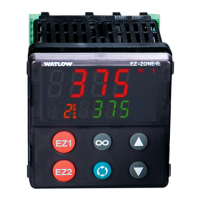Watlow EZ-ZONE
®
PMI Controller • 64 • Chapter 4 Home Page
Display
Visual information from the control is displayed to the observer using a fairly standard 7
segment display. Due to the use of this technology, several characters displayed need some
interpretation, see the list below:
1 = 1 ϯ = 7
щ
, { = c i = i o = o u, U = u
2 = 2 8 = 8 ц = d J = J P = P u, U = v
3 = 3 q = 9 E = E H = K q = q ФІ = W
4 = 4 0 = 0 F = F L = L r = r y = y
5 = 5 џ = A g = g ЛЏ = M S = S Z = Z
6 = 6 b = b h = h n = n t = t
Range
Within this column notice that on occasion there will be numbers found within parenthesis.
This number represents the enumerated value for that particular selection. Range selections
can be made simply by writing the enumerated value of choice using any of the available
communications protocols. As an example, turn to the Setup Page and look at the Analog
Input
Ai
menu and then the Sensor Type sEn prompt. To turn the sensor off using Modbus
simply write the value of 62 (off) to register 368 and send that value to the control.
Communication Protocols
When using a communications protocol in conjunction with the EZ-ZONE PM there are two
possible ports (instances) used. Port 1 or instance 1 is always dedicated to Standard Bus com-
munications. This same instance can also be used for Modbus RTU if ordered. Depending on
the controller part number, port 2 (instance 2) can be used with Modbus, CIP, J1939 CAN and
Probus. For further information read through the remainder of this section.
Modbus Introduction to the Modbus Protocol
Gould Modicon, now called AEG Schneider, rst created the protocol referred to as "Modbus
RTU" used in process control systems. Modbus provides the advantage of being extremely
reliable in exchanging information, a highly desirable feature for industrial data communi-
cations. This protocol works on the principle of packet exchanges. The packet contains the
address of the controller to receive the information, a command eld that says what is to
be done with the information, and several elds of data. Each PM parameter has a unique
Modbus address and they can be found in the following Operations, Setup, Proling, and Fac-
tory Pages.
All Modbus registers are 16-bits and as displayed in this User's Guide are relative addresses
(actual). Some legacy software packages limit available Modbus registers to 40000 to 49999
(5 digits). Many applications today require access to all available Modbus registers which
range from 400000 to 465535 (6 digits). For parameters listed as oat, notice that only one
(low order) of the two registers is listed; this is true throughout this document. By default,
the low order word contains the two low bytes of the 32-bit parameter. As an example, look
in the Operations Page for the Analog Input Value. Find the column identied in the header
as Modbus and notice that it lists register 360. Because this parameter is a oat it is actually
represented by registers 360 (low order bytes) and 361 (high order bytes). The Modbus speci-
cation does not dictate which register should be high or low order therefore, Watlow pro-
vides the user the ability to swap this order (Setup Page, CoЛЏ Menu) from the default low/
high
Lohi
to high/low
hiLo
.

